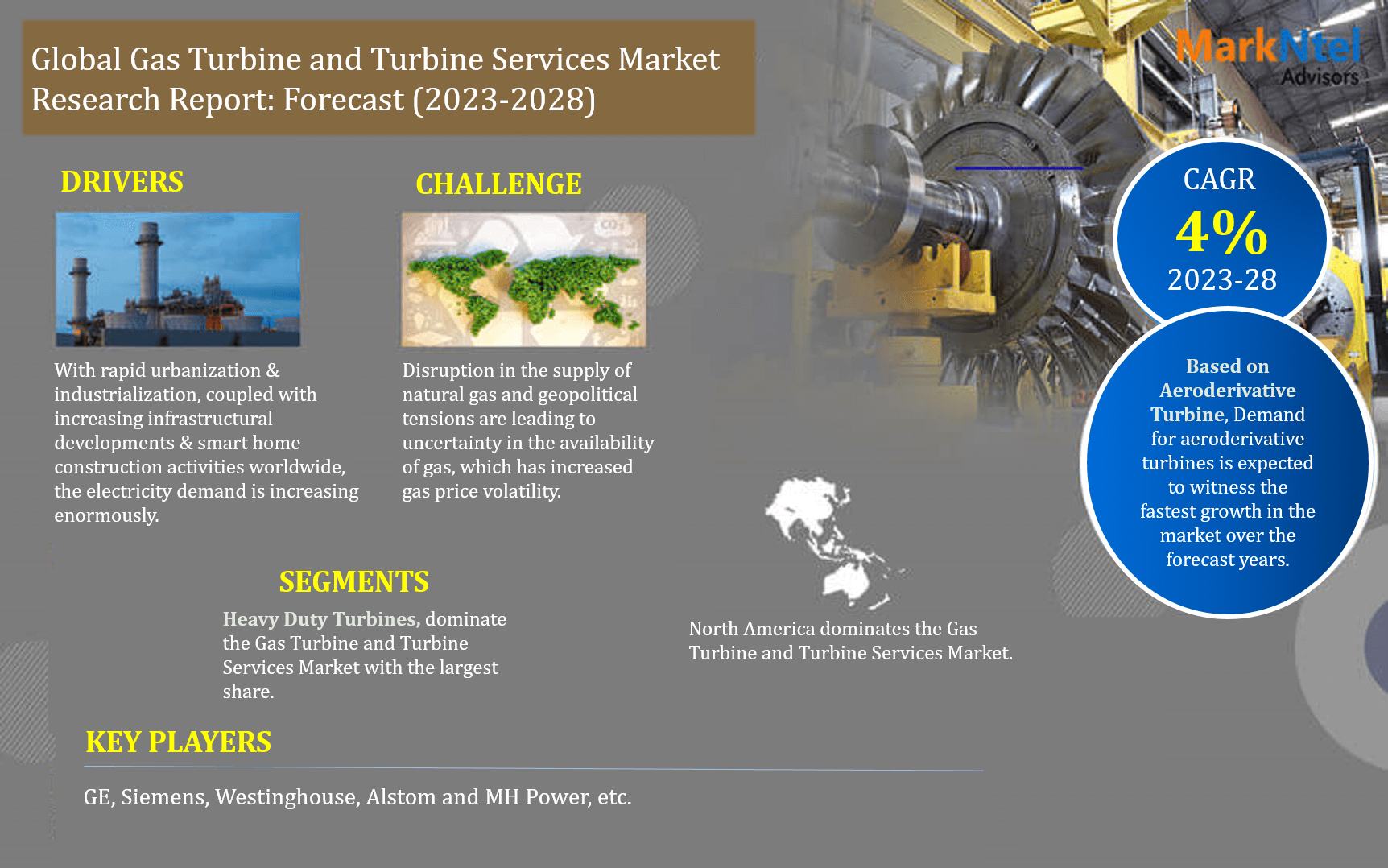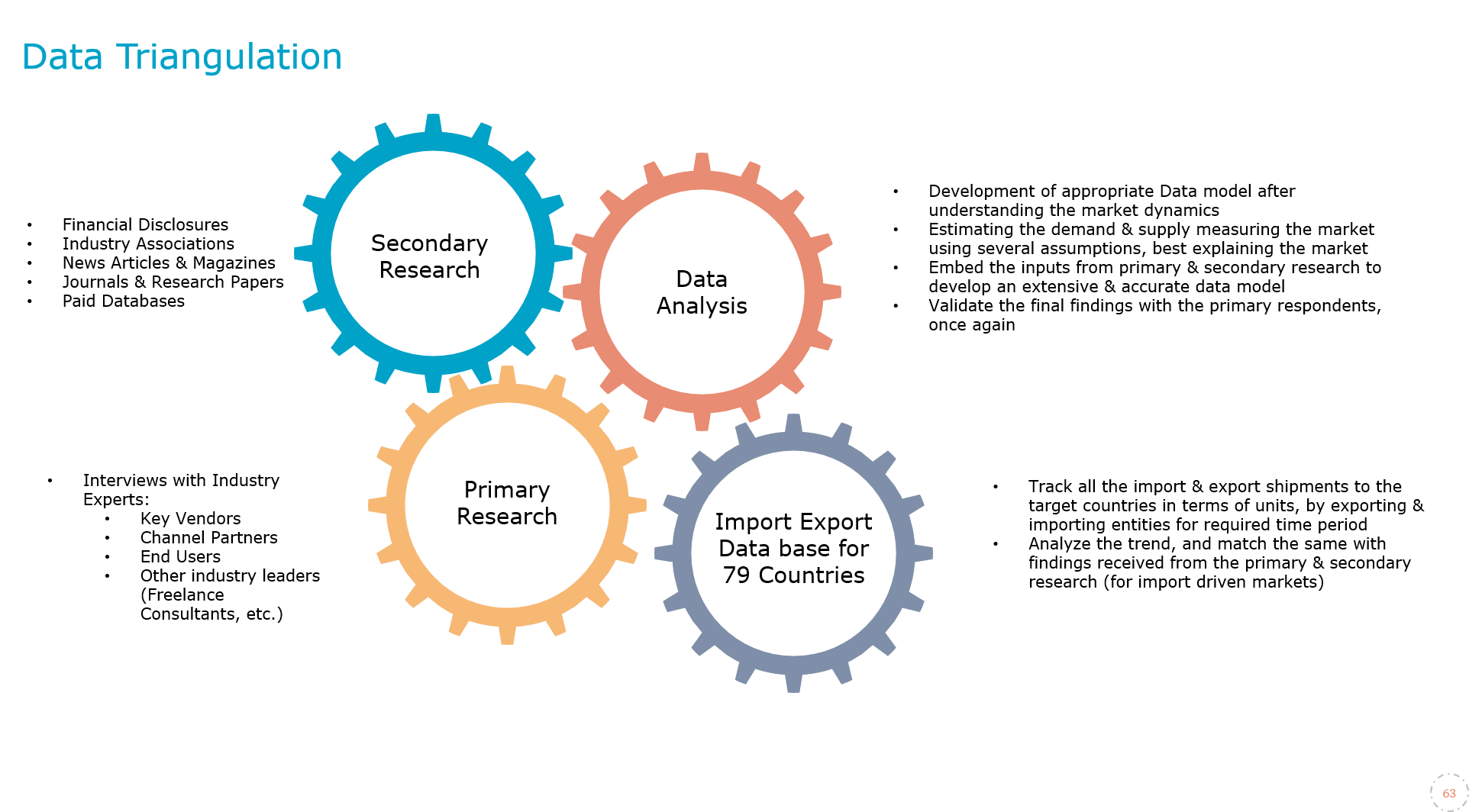
Global Gas Turbine and Turbine Services Market Research Report: Forecast (2023-2028)
By Type (Gas Turbine Sales [Heavy Duty Turbine, Aero derivative Turbine, Industrial Turbine], Gas Turbine Services [Overhaul, Maintenance and Repair]), By Service Provider (OEM, No...n-OEM), By Application (Power Generation, Oil & Gas, Other Industrial Application), By Capacity (Below 15 MW, Above 15 MW), By Region (North America, South America, Europe, Asia-Pacific, Middle East & Africa), By Country (US, Canada, Mexico, Brazil, Argentina, The UK, Germany, France, UAE, Saudi Arabia, South Africa, Iran, Iraq, Oman, Kuwait, Egypt, Qatar, China, Japan, South Korea, India, Singapore, Malaysia, Vietnam, Indonesia), By Company (General Electric, Alstom, Siemens AG, Mitsubishi Hitachi Power Systems, Ltd., Kawasaki Heavy Industries, Ltd., Ansaldo Energia S.P.A., BHEL, Westinghouse, Sulzer AG, MH Power, Ethos Energy, MJB International, MTU Aero Engines AG, Turbine Services and Solutions LLC, Solar Turbines Incorporated, and Centrax Gas Turbines) Read more
- Energy
- Mar 2023
- Pages 211
- Report Format: PDF, Excel, PPT
Market Definition
A gas turbine is a combustion engine that converts natural gas & other fuels into mechanical energy for generating electrical energy. These highly efficient engines are gradually replacing the oil & gas-fired power plants with a combined cycle power plant that utilizes such turbines. The services provided by the gas turbine are called gas turbine services. Moreover, they can work under high operating temperatures and mechanical stress, which instigates the need for turbine repair & maintenance services. Gas turbines are used most commonly for distributed energy applications. The need to ensure the peak performance of the turbines is driven by the ever-increasing higher peak loads in utilities. Frequent maintenance is the highly preferred way for ensuring the highly effective performance of gas turbines.
Market Insights & Analysis: Global Gas Turbine and Turbine Services Market (2023-28)
The Global Gas Turbine and Turbine Services Market is projected to grow at a CAGR of around 4% during the forecast period, i.e., 2023-28. Most of the market would be driven by the uplifting demand for highly efficient gas turbines, reduction in the prices of natural gas, and surging shale gas production. Gas turbine services provide reduced operational costs & improved safety & life of the equipment. However, the need for specialized & trained human power to stimulate the turbines makes it an expensive process. Moreover, increasing environmental concerns due to rising carbon emissions via coal-based power generation are propelling the adoption of natural gas-based turbines, globally.
| Report Coverage | Details |
|---|---|
| Study Period | Historical Data: 2018-21 |
| Base Year: 2022 | |
| Forecast Period: 2023-28 | |
| CAGR (2023-2028) | 4% |
| Regions Covered | North America: The US, Canada, Mexico |
| Europe: Germany, The UK, France | |
| Asia-Pacific: China, India, Japan, South Korea, Indonesia, Vietnam, Singapore, Malaysia | |
| South America: Brazil, Argentina | |
| Middle East & Africa: The UAE, Saudi Arabia, South Africa, Iran, Iraq, Oman, Kuwait, Egypt, Qatar | |
| Key Companies Profiled | General Electric, Alstom, Siemens AG, Mitsubishi Hitachi Power Systems, Ltd., Kawasaki Heavy Industries, Ltd., Ansaldo Energia S.P.A., BHEL, Westinghouse, Sulzer AG, MH Power, Ethos Energy, MJB International, MTU Aero Engines AG, Turbine Services and Solutions LLC, Solar Turbines Incorporated, Centrax Gas Turbines |
| Unit Denominations | USD Million/Billion |
Companies are providing multi-year service contracts to their end-users that include either Basic or Overall Maintenance. Basic maintenance only involves preventive measures and overall maintenance includes repairing defective equipment. Since these multi-year agreements are quite economical, their growing adoption worldwide is creating lucrative opportunities for the market.
Natural gas-powered turbines are enjoying a significant increase in demand, especially across Europe & North America. However, emerging economies like India & China are still under coal-based power generation owing to lower costs. This factor might doesn't seems to be a prominent restraint for sales & maintenance contracts of new gas turbines. Besides, limited natural gas reserves shall also hinder market growth in the years to come.
Global Gas Turbine and Turbine Services Market Driver:
Escalating Energy Requirements Worldwide - With rapid urbanization & industrialization, coupled with increasing infrastructural developments & smart home construction activities worldwide, the electricity demand is increasing enormously. To cater to these requirements, both public & private sectors are either installing new power plants or expanding the capacity of their existing ones, i.e., leading to increasing installation of gas turbines in these power plants as they are less harmful. These trends project lucrative prospects for the Gas Turbine and Turbine Services Market during 2023-28.
Global Gas Turbine and Turbine Services Market Possible Restraint:
Fluctuating Prices of Natural Gas - The advent of Covid-19 in 2020 negatively impacted the demand for natural gas. Disruption in the supply of natural gas and geopolitical tensions are leading to uncertainty in the availability of gas, which has increased gas price volatility. Because of shale gas exploitation, gas prices in the US have declined dramatically. Though, prices are comparatively high in the rest of the world. These aspects are likely to restrain the growth of the Gas Turbine and Turbine Services Market in the coming years.

Global Gas Turbine and Turbine Services Market (2023-28): Segmentation Analysis
The Global Gas Turbine and Turbine Services Market study of MarkNtel Advisors evaluates & highlights the major trends & influencing factors in each segment & includes predictions for the period 2023–2028 at the global, regional, and national levels. Based on the analysis, the market has been further classified as:
Based on Type:
- Gas Turbine Sales
- Heavy Duty Turbine
- Aeroderivative Turbine
- Industrial Turbine
- Gas Turbine Services
- Overhaul
- Maintenance & Repair
Of them all, Heavy Duty Turbines dominate the Gas Turbine and Turbine Services Market with the largest share. It owes to their high-capacity operations, economic cost structure, & lower pressure ratios to yield high specific power, as well as the surging number of manufacturing plants globally. Moreover, smaller dimensions, low investment costs, & maximum cycle efficiency associated with heavy-duty turbines make them suitable for heat recovery power generating plants and the power & utility industry. Additionally, the rapid expansion of captive generating power stations owing to the growing electricity demand in the industrial sector is another prominent aspect boosting the demand for heavy-duty turbines.
On the other hand, the demand for aeroderivative turbines is expected to witness the fastest growth in the global market over the forecast years, owing to their ever-growing utilization in utility generation, district heating, and marine propulsion. These turbines are lighter in weight, take up less space, & emit low emissions and enable renewables to operate when needed, which helps save fuel. Besides, they are designed for immediate removal & replacement facilitating fast maintenance & greatly reduced downtimes. Hence, considering these aspects, aeroderivative turbines are very likely to witness increasing demand in the years ahead.
Based on Application:
- Power Generation
- Oil & Gas
- Other Industrial Application
Here, power Generation carries the largest share in the Global Gas Turbine and Turbine Services market. With the rising government focus on reducing the use of coal-based power plants to minimize carbon emissions, the demand for gas turbines for power generation application is dramatically rising worldwide.
On the other hand, the increasing consumption of oil & gas worldwide is also contributing to the burgeoning demand for gas turbines. In addition to this, stringent emission norms & low prices of natural gases would further escalate the usage of gas turbines in the oil & gas industry over the forecast years.
Global Gas Turbine and Turbine Services Market Regional Projection
- North America
- South America
- Europe
- Asia-Pacific
- The Middle East & Africa
Of all regions globally, North America dominates the Gas Turbine and Turbine Services Market. It owes to the extensive availability of gas-driven turbine plants and a surge in shale gas exploration activities across the region. In 2020, the US Energy Information Administration (EIA) said, Natural gas generates about 40% of US electricity. Coal was the third-largest energy source for US electricity generation, accounting for around 19%. As a result, the increasing use of natural gas in North America, especially across the US is fueling the regional market growth.
On the other front, Asia-Pacific is projected to witness the fastest market growth during 2023-28 due to the increasing energy demand on account of rapid urbanization & industrialization. In addition, the shift from the coal-based for power production to clean energy sources owing to stringent government norms to reduce carbon emissions is another crucial aspect projected to boost the Asia-Pacific Gas Turbine and Turbine Services Market in the years to come.
Gain a Competitive Edge with Our Global Gas Turbine and Turbine Services Market Report
- Global Gas Turbine and Turbine Services Market report provides a detailed and thorough analysis of market size, growth rate, competitive landscape, and key players. This comprehensive analysis helps businesses gain a holistic understanding of the market dynamics and make informed decisions.
- This report also highlights current market trends and future projections, allowing businesses to identify emerging opportunities and potential challenges. By understanding market forecasts, companies can align their strategies and stay ahead of the competition.
- Global Gas Turbine and Turbine Services industry report aids in assessing and mitigating risks associated with entering or operating in the market.
- The report would help in understanding market dynamics, regulatory frameworks, and potential challenges, businesses can develop strategies to minimize risks and optimize their operations.
Frequently Asked Questions
Global Gas Turbine and Turbine Services Market Research Report (2023-2028) - Table of Contents
- Introduction
- Research Process
- Assumption
- Market Segmentation
- Market Definition
- Executive Summary
- Expert Verbatim- What our Experts Say?
- Global Gas Turbine & Turbine Services Market Dynamics
- Growth Drivers
- Challenges
- Impact Analysis
- Global Gas Turbine & Turbine Services Market Trends & Insights
- Global Gas Turbine & Turbine Services Market Policies, Regulations, Standards
- List of Independent Turbine Maintenance and Repair Service Providers, By Region
- North America
- Europe
- Asia Pacific
- Middle East & Africa
- South America
- List of Original Equipment Manufacturers, By Region
- Global Gas Turbine & Turbine Services Market Analysis, 2018-2028
- Market Size and Analysis
- By Revenues
- By Volume
- By Type
- Gas Turbine Sales
- Heavy Duty Turbine
- Aeroderivative Turbine
- Industrial Turbine
- Gas Turbine Services
- Overhaul
- Maintenance and Repair
- Gas Turbine Sales
- By Service Provider
- OEM
- Non-OEM
- By Application
- Power Generation
- Oil & Gas
- Other Industrial Application
- By Capacity
- 30 MW and Below
- 31 MW to 100 MW
- 101 MW to 200 MW
- Above 200 MW
- By Region
- North America
- Europe
- Asia Pacific
- Middle East & Africa
- South America
- By Company
- Revenue Shares
- Market Size and Analysis
- North America Gas Turbine & Turbine Services Market Analysis, 2018-2028
- Market Size and Analysis
- By Revenues
- By Volume
- Market Share and Analysis
- By Type
- By Service Provider
- By Application
- By Capacity
- By Country
- The US
- Canada
- Mexico
- The US Gas Turbine & Turbine Services Market Analysis, 2018-2028
- Market Size and Analysis
- By Revenues
- By Volume
- Market Share and Analysis
- By Type
- By Service Provider
- By Application
- By Capacity
- Market Size and Analysis
- Canada Gas Turbine & Turbine Services Market Analysis, 2018-2028
- Market Size and Analysis
- By Revenues
- By Volume
- Market Share and Analysis
- By Type
- By Service Provider
- By Application
- By Capacity
- Market Size and Analysis
- Mexico Gas Turbine & Turbine Services Market Analysis, 2018-2028
- Market Size and Analysis
- By Revenues
- By Volume
- Market Share and Analysis
- By Type
- By Service Provider
- By Application
- By Capacity
- Market Size and Analysis
- Market Size and Analysis
- South America Gas Turbine & Turbine Services Market Analysis, 2018-2028
- Market Size and Analysis
- By Revenues
- By Volume
- Market Share and Analysis
- By Type
- By Service Provider
- By Application
- By Capacity
- By Country
- Brazil
- Argentina
- Others
- Brazil Gas Turbine & Turbine Services Market Analysis, 2018-2028
- Market Size and Analysis
- By Revenues
- By Volume
- Market Share and Analysis
- By Type
- By Service Provider
- By Application
- By Capacity
- Market Size and Analysis
- Argentina Gas Turbine & Turbine Services Market Analysis, 2018-2028
- Market Size and Analysis
- By Revenues
- By Volume
- Market Share and Analysis
- By Type
- By Service Provider
- By Application
- By Capacity
- Market Size and Analysis
- Market Size and Analysis
- Europe Gas Turbine & Turbine Services Market Analysis, 2018-2028
- Market Size and Analysis
- By Revenues
- By Volume
- Market Share and Analysis
- By Type
- By Service Provider
- By Application
- By Capacity
- By Country
- Germany
- The UK
- France
- Others
- Germany Gas Turbine & Turbine Services Market Analysis, 2018-2028
- Market Size and Analysis
- By Revenues
- By Volume
- Market Share and Analysis
- By Type
- By Service Provider
- By Application
- By Capacity
- Market Size and Analysis
- The UK Gas Turbine & Turbine Services Market Analysis, 2018-2028
- Market Size and Analysis
- By Revenues
- By Volume
- Market Share and Analysis
- By Type
- By Service Provider
- By Application
- By Capacity
- Market Size and Analysis
- France Gas Turbine & Turbine Services Market Analysis, 2018-2028
- Market Size and Analysis
- By Revenues
- By Volume
- Market Share and Analysis
- By Type
- By Service Provider
- By Application
- By Capacity
- Market Size and Analysis
- Market Size and Analysis
- Asia-Pacific Gas Turbine & Turbine Services Market Analysis, 2018-2028
- Market Size and Analysis
- By Revenues
- By Volume
- Market Share and Analysis
- By Type
- By Service Provider
- By Application
- By Capacity
- By Country
- China
- India
- Japan
- South Korea
- Indonesia
- Vietnam
- Others
- China Gas Turbine & Turbine Services Market Analysis, 2018-2028
- Market Size and Analysis
- By Revenues
- By Volume
- Market Share and Analysis
- By Type
- By Service Provider
- By Application
- By Capacity
- Market Size and Analysis
- India Gas Turbine & Turbine Services Market Analysis, 2018-2028
- Market Size and Analysis
- By Revenues
- By Volume
- Market Share and Analysis
- By Type
- By Service Provider
- By Application
- By Capacity
- Market Size and Analysis
- Japan Gas Turbine & Turbine Services Market Analysis, 2018-2028
- Market Size and Analysis
- By Revenues
- By Volume
- Market Share and Analysis
- By Type
- By Service Provider
- By Application
- By Capacity
- Market Size and Analysis
- South Korea Gas Turbine & Turbine Services Market Analysis, 2018-2028
- Market Size and Analysis
- By Revenues
- By Volume
- Market Share and Analysis
- By Type
- By Service Provider
- By Application
- By Capacity
- Market Size and Analysis
- Indonesia Gas Turbine & Turbine Services Market Analysis, 2018-2028
- Market Size and Analysis
- By Revenues
- By Volume
- Market Share and Analysis
- By Type
- By Service Provider
- By Application
- By Capacity
- Market Size and Analysis
- Vietnam Gas Turbine & Turbine Services Market Analysis, 2018-2028
- Market Size and Analysis
- By Revenues
- By Volume
- Market Share and Analysis
- By Type
- By Service Provider
- By Application
- By Capacity
- Market Size and Analysis
- Market Size and Analysis
- Middle East & Africa Gas Turbine & Turbine Services Market Analysis, 2018-2028
- Market Size and Analysis
- By Revenues
- By Volume
- Market Share and Analysis
- By Type
- By Service Provider
- By Application
- By Capacity
- By Country
- UAE
- Saudi Arabia
- Qatar
- South Africa
- Egypt
- Others
- UAE Gas Turbine & Turbine Services Market Analysis, 2018-2028
- Market Size and Analysis
- By Revenues
- By Volume
- Market Share and Analysis
- By Type
- By Service Provider
- By Application
- By Capacity
- Market Size and Analysis
- Saudi Arabia Gas Turbine & Turbine Services Market Analysis, 2018-2028
- Market Size and Analysis
- By Revenues
- By Volume
- Market Share and Analysis
- By Type
- By Service Provider
- By Application
- By Capacity
- Market Size and Analysis
- Qatar Gas Turbine & Turbine Services Market Analysis, 2018-2028
- Market Size and Analysis
- By Revenues
- By Volume
- Market Share and Analysis
- By Type
- By Service Provider
- By Application
- By Capacity
- Market Size and Analysis
- Egypt Gas Turbine & Turbine Services Market Analysis, 2018-2028
- Market Size and Analysis
- By Revenues
- By Volume
- Market Share and Analysis
- By Type
- By Service Provider
- By Application
- By Capacity
- Market Size and Analysis
- South Africa Gas Turbine & Turbine Services Market Analysis, 2018-2028
- Market Size and Analysis
- By Revenues
- By Volume
- Market Share and Analysis
- By Type
- By Service Provider
- By Application
- By Capacity
- Market Size and Analysis
- Market Size and Analysis
- Competitive Landscape
- Competitive benchmarking (Mapping companies based on services offered,
- Company Profiles (Company Profiles (Business Description, Segments, Business Segments, Financials, Strategic Alliances/ Partnerships, Future Plans)
- General Electric
- Siemens AG
- Mitsubishi Hitachi Power Systems, Ltd.
- Kawasaki Heavy Industries, Ltd.
- Ansaldo Energia S.P.A.
- BHEL
- Westinghouse
- Sulzer AG
- MH Power
- EthosEnergy
- MJB International
- MTU Aero Engines AG
- Turbine Services and Solutions LLC
- Solar Turbines Inc.
- Centrax Gas Turbines
- Others
- Disclaimer
MarkNtel Advisors follows a robust and iterative research methodology designed to ensure maximum accuracy and minimize deviation in market estimates and forecasts. Our approach combines both bottom-up and top-down techniques to effectively segment and quantify various aspects of the market. A consistent feature across all our research reports is data triangulation, which examines the market from three distinct perspectives to validate findings. Key components of our research process include:
1. Scope & Research Design At the outset, MarkNtel Advisors define the research objectives and formulate pertinent questions. This phase involves determining the type of research—qualitative or quantitative—and designing a methodology that outlines data collection methods, target demographics, and analytical tools. They also establish timelines and budgets to ensure the research aligns with client goals.
2. Sample Selection and Data Collection In this stage, the firm identifies the target audience and determines the appropriate sample size to ensure representativeness. They employ various sampling methods, such as random or stratified sampling, based on the research objectives. Data collection is carried out using tools like surveys, interviews, and observations, ensuring the gathered data is reliable and relevant.
3. Data Analysis and Validation Once data is collected, MarkNtel Advisors undertake a rigorous analysis process. This includes cleaning the data to remove inconsistencies, employing statistical software for quantitative analysis, and thematic analysis for qualitative data. Validation steps are taken to ensure the accuracy and reliability of the findings, minimizing biases and errors.

4. Data Forecast and FinalizationThe final phase involves forecasting future market trends based on the analyzed data. MarkNtel Advisors utilize predictive modeling and time series analysis to anticipate market behaviors. The insights are then compiled into comprehensive reports, featuring visual aids like charts and graphs, and include strategic recommendations to inform client decision-making









